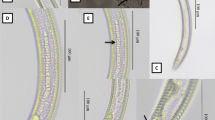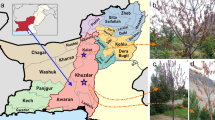Abstract
A survey was conducted in the agricultural fields of mustard of Haridwar district, Uttarakhand, India, where a heavy population of Zeldia was recovered. The morphological, molecular, and phylogenetic characterization confirmed the nematode as Zeldia punctata. The phylogenetic analysis based on 18 and 28S rDNA placed the studied population of Z. punctata close to other populations of the same species. The principal component analysis (PCA) data revealed the high intraspecific and interspecific variations between the populations of Zeldia punctata from different geographical regions. The result indicated a variation between the Indian populations of Z. punctata. Additionally, the selected ecological factors indicated an impact of EC, temperature, and phosphorus on Z. punctata during the flowering and podding time of mustard crops in India. However, the PCA revealed no effect of ecological factors on the nematode diversity indices. In conclusion, Z. punctata, with its high individual numbers on mustard, may affect crop production due to activating the bacterial community of the soil and less space for plant-parasitic nematodes.






Similar content being viewed by others
Data availability
The data and material of this manuscript are available from the corresponding author on reasonable request.
References
Abolafia J, Peña-Santiago R (2003) Nematodes of the Order Rhabditida from Andalucía Oriental, Spain. The Genera Nothacrobeles Allen & Noffsinger, 1971 and Zeldia Thorne, 1937. J Nematol 35(3):233–243
Abolafia J, Peña-Santiago R (2018) On the identity of Chiloplacus subtenuis Rashid & Heyns, 1990 and C. tenuis Rashid & Heyns, 1990 (Rhabditida: Cephalobidae), with description of C. mysteriosus sp. n. Nematology 20(1):49–66. https://doi.org/10.1163/15685411-00003124
Abolafia J, Shokoohi E (2019) Soil and freshwater rhabditid nematodes (Nematoda, Rhabditida) from Iran: a compendium. Universidad de Jaén, Spain, pp 1–223
Abolafia J, Vecchi M (2021) Redescription and phylogenetic analysis of the type species of the genus Panagrellus Thorne, 1938 (Rhabditida, Panagrolaimidae), P. pycnus Thorne, 1938, including the first SEM study. J Nematol 53(1):1–20. https://doi.org/10.21307/jofnem-2021-080
Addinsoft (2007) XLSTAT, analyse de données et statistique avec MS Excel. Addinsoft, New York
Allen MW, Noffsinger EM (1972) A review of the genus Zeldia Thorne, 1937 (Nematoda: Cephalobidae) with descriptions of seven new species. Proc Helminthol Soc Wash 39:206–223
SF, Gish W, Miller W, Myers EW, Lipman DJ (1990) Basic local alignment search tool. J Mol Biol 215:403–410
Andrássy I (1967) Ergebnisse der zoologischen Forschungen von Dr. Z. Kaszab in der Mongolei. 92. Weitere Bodennematoden aus den Jahren 1964 und 1965. Opusc Zool Budapest 7:203–233
Andrássy I (2005) Free-living nematodes of Hungary (Nematoda Errantia). Pedozoologica Hungarica 3 1:518
Bharti L, Bhat AH, Chaubey AK, Abolafia J (2020) Morphological and molecular characterisation of Merlinius brevidens (Allen, 1955) Siddiqi, 1970 (Nematoda: Rhabditida: Merlinidae) from India. J Nat Hist 54(23–24):1477–1498. https://doi.org/10.1080/00222933.2020.1810352
Boström S (1992) Some Cephalobidae (Nematoda: Rhabditida) from Crete, Greece. Fundam Appl Nematol 15:289–295
Cobb NA (1918) Estimating the nematode population of soil. United States Department Agri Tech Circu 1:1–48
Courtney WD, Polley D, Miller VL (1955) TAF, an improved fixative in nematode technique. Plant Dis Rep 39:570–571
Darriba D, Taboada GL, Doallo R, Posada D (2012) jModelTest 2: more models, new heuristics and parallel computing. Nat Methods 9:772
De Bruin S, Heyns J (1993) Cephalobidae (Nematoda: Rhabditida) from Botswana. Phytophylactica 25:1–10
De Ley P, Geraert E, Coomans A (1990) Seven cephalobids from Senegal (Nematoda: Rhabditida). J Afr Zool 104(4):287–304
De Ley P, Félix MA, Frisse LM, Nadler SA, Sternberg PW, Thomas WK (1999) Molecular and morphological characterisation of two reproductively isolated species with mirror-image anatomy (Nematoda: Cephalobidae). Nematology 1:591–612
De Man JG (1880) Die einheimischen, frei in der reinen Erde und im süssen Wasser lebenden Nematoden. Tijdschriftder Nederlandsche Dierkundige Vereeniging 5:1–104
Dwivedi S, Mishra R (2020) Effect of integrated plant nutrient management practices on quality characteristics of mustard seed. J Pharmacogn Phytochem 9(6S):175–179
Floyd RM, Rogers AD, Lambshead PJD, Smith CR (2005) Nematode-specific PCR primers for the 18S small subunit rRNA gene. Mol Ecol Notes 5(3):611–612. https://doi.org/10.1111/j.1471-8286.2005.01009.x
Goodey JB (1957) Laboratory methods for work with plant and soil nematodes.Technical Bulletin No. 2 Ministry of Agriculture, Fisheries and Food, London, 47 pp
Hall TA (1999) BioEdit: a user-friendly biological sequence alignment and analysis program for Windows 95/98.NT. Nucleic Acids Symp Ser 41:95–98
Heyns J (1962) Osstellahamata n. gen., n. sp., Zeldia serrata n. sp. and Acrobeles thornei n. sp., three new nematodes from South Africa (Rhabditida: Cephalobidae). Nematologica 8(4):301–306
Holovachov O, Camp L, Nadler SA (2015) Sensitivity of ribosomal RNA character sampling in the phylogeny of Rhabditida. J Nematol 47(4):337
Kiontke K, Barrière A, Kolotuev I, Podbilewicz B, Sommer R, Fitch DH, Félix MA (2007) Trends, stasis, and drift in the evolution of nematode vulva development. Curr Biol 17(22):1925–1937
Kumar S, Stecher G, Tamura K (2016) MEGA7: molecular evolutionary genetics analysis version 7.0 for bigger datasets. Mol Biol Evol 33:1870–1874. https://doi.org/10.1093/molbev/msw054
Mehdizadeh S, Shokoohi E (2013) The genera Nothacrobeles Allen & Noffsinger, 1971 and Zeldia Thorne, 1937 (Nematoda: Rhabditida: Cephalobidae) from southern Iran, with description of N. abolafiai sp. n. Zootaxa 3637(3):325–340. https://doi.org/10.11646/zootaxa.3637.3.5
Nadler SA, Bolotin E, Stock SP (2006) Phylogenetic relationships of Steinernema Travassos, 1927 (Nematoda: Cephalobina: Steinernematidae) based on nuclear, mitochondrial and morphological data. Syst Parasitol 63(3):159–179. https://doi.org/10.1007/s11230-005-9009-3
Norton DC (1978) Ecology of plant parasitic nematodes. John Wiley and Sons, New York, p 268
Rashid F, Heyns J (1990) Description of Namibinema scaphovulva n. gen., n. sp. and Zeldia punctata (Thome, 1925) from Namibia (Nematoda: Cephalobidae). Phytophylactica 22(4):397–403
Rashid F, Geraert E, Sharma RD (1985) Morphology, taxonomy and morphometry of some Cephalobidae (Nematoda: Rhabditida) from Brazil with descriptions of two new genera and four new species. Nematologica 30 (1984): 251–299
Ronquist F, Teslenko M, van der Mark P, Ayres DL, Darling A, Höhna S, Larget B, Liu L, Suchard MA, Huelsenbeck JP (2012) MrBayes 3.2: efficient bayesian phylogenetic inference and model choice across a large model space. Syst Biol 61:539–542. https://doi.org/10.1093/sysbio/sys029
Seinhorst JW (1959) A rapid method for the transfer of nematodes from fixative to anhydrous glycerin. Nematologica 4:67–69
Sharma H, Chaubey AK (2023) Molecular and phenotypic characterization of Hemicriconemoides rosae (Rathour 2003) from mustard rhizosphere in India. JOBAZ 84(1):1–15. https://doi.org/10.1186/s41936-023-00338-6
Shekhawat K, Rathore SS, Premi OP, Kandpal BK, Chauhan JS (2012) Advances in agronomic management of Indian mustard (Brassica juncea (L.) Czernj. Cosson): an overview. Int J Agron. 2012:1–14. https://doi.org/10.1155/2012/408284
Shokoohi E, Mashela PW, Machado RA (2022) Bacterial communities associated with Zeldia punctata, a bacterivorous soil-borne nematode. Int Microbiol 1–10. https://doi.org/10.1007/s10123-021-00207-8
Southey JF (1974) New or unusual host-plant records for plant-parasitic nematodes, 1971–73. J Plant Pathol 23(1):45–46
Southey JF (1985) Laboratory methods for work with plant and soil nematodes.Ministry of Agriculture, Fisheries and Food, Reference Book 402, London
Steiner G (1935) Opuscula Miscellanea Nematologica, I. Proc Helm Soc Wash 2(1):41–45
Steiner (1938) Opuscula Miscellanea Nematological VII. (1). Observations on nematodes associated with Irish potatoes grown in South Carolina. Proc Helm Soc Wash 5:35–40
Tabassum KA, Shahina F (2002) Re-description of four known cephalobids (Nemata: Cephalobidae) from Pakistan. Pak J Nematol 20:25–37
Tahseen Q, Ahmad I, Jairajpuri MS (1999) Observations on three species of the subfamily Acrobelinae (Nematoda: Cephalobidae) from India. Nematology 1:527–537
Thorne G (1925) The genus Acrobeles Von Linstow, 1887. Trans Am Micros Soc 44:171–210
Thorne G (1937) A revision of the nematode family Cephalobidae Chitwood and Chitwood 1934. Proc Helm Soc Wash 4:1–16
Von Linstow O (1877) Helminthologische Beobachtungen. Arch Naturgesch Jahrg 42 Bd 1:1876
Waceke JW, Bumbarger DJ, Mundo-Ocampo M, Subbotin SA, Baldwin JG (2005) Zeldia spannata sp. n. (Nematoda: Cephalobidae) from the Mojave Desert. Calif JNMS 8(1):57–67
Wasilewska L (1979) The structure and function of soil nematode communities in natural ecosystem agrocenoses. Pol J Environ Stud 5:97–145
Yeates GW (1967) Studies on nematodes from dune sands. 5 Acrobelinae. NZ J Sci 10:527–547
Yeates GW (1984) Variation in soil nematode diversity under pasture with soil and year. Soil Biol Biochem 16:95–102
Acknowledgements
The authors thank the Department of Zoology, Chaudhary Charan Singh University, Meerut, for providing the necessary laboratory facilities for conducting the experiments. Head SAIF AIIMS, New Delhi, is also being acknowledged for providing scanning electron microscopic facilities.
Funding
The authors declare that no funds, grants, or other support were received during the preparation of this manuscript.
Author information
Authors and Affiliations
Contributions
The study was designed by HS and AKC. Interpretation of the data was done by HS and ES. Manuscript writing was done by HS. Tables and reference settings were done by LB and HS. Errors and grammatical mistakes in the manuscript were removed and edited by AKC and ES. Then, the final manuscript was read and approved by all authors.
Corresponding author
Ethics declarations
Ethical approval
This article does not contain any studies with human participants or animals.
Competing interests
The authors declare that they have no competing interests.
Additional information
Publisher’s Note
Springer Nature remains neutral with regard to jurisdictional claims in published maps and institutional affiliations.
Rights and permissions
Springer Nature or its licensor (e.g. a society or other partner) holds exclusive rights to this article under a publishing agreement with the author(s) or other rightsholder(s); author self-archiving of the accepted manuscript version of this article is solely governed by the terms of such publishing agreement and applicable law.
About this article
Cite this article
Sharma, H., Bharti, L., Chaubey, A.K. et al. Comparative morphometrics, molecular characterization, and dynamic population of Zeldia punctata associated with mustard crops from India. Biologia (2024). https://doi.org/10.1007/s11756-024-01658-w
Received:
Accepted:
Published:
DOI: https://doi.org/10.1007/s11756-024-01658-w




